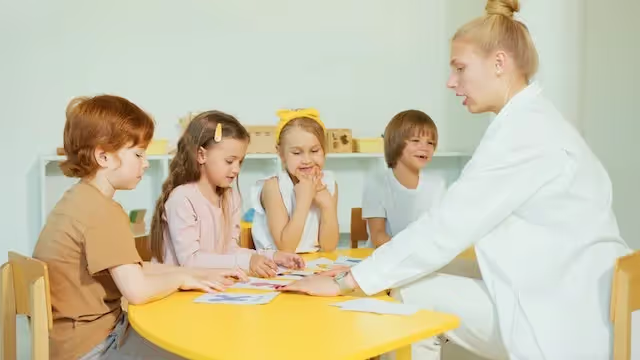Behavioral Skills Training (BST) In ABA Therapy
Behavioral Skills Training is a common method of training that is used to instruct anyone who has worked regularly with learners.

What Is Behavioral Skills Training (BST)?
Behavioral Skills Training (BST) is a common method of training that is used to instruct anyone who has worked regularly with learners, like teaching staff and parents/caregivers.
%252520In%252520ABA%252520Therapy.avif)
BST combines competency and performance to help learn a set of skills or a particular skill that needs help.
Unlike some training, BST gets away from the long lectures that used to be used to teach new skills. Why?
Think back to when you were in school or some other form of training and you had to sit for hours on end listening to a lecture.
By the end of the lecture, how much did you remember and how proficient were you in the skill the lecture was teaching?
4 Steps Of Behavioral Skills Training
The four steps to BST are instruction, modeling, rehearsal, and feedback. Each of these steps is important for BST to work properly. Here is how each step works.
Instruction
This step is rather simple. The person that is leading the BST will provide instructions to the caregivers and professionals that are taking the training clearly and concisely.
These instructions should be easy to remember, and they should always highlight the main teaching points that they want to get across so those taking the training.
During this step of BST, it is important to provide visual cues, as well, as to help people remember.This step is also important because people who understand why they are teaching something will be able to do so more effectively. How does this step coincide with ABA therapy?
Well, if your client is having issues with waiting, you wouldn't be able to thoroughly help them with this skill without understanding why it is important.
This step helps to teach caregivers this.Why would waiting be an important behavioral skill that would need to be learned?
With children with autism and other behavioral issues, parents might not be able to drop what they are doing every time their child needs them. They could be dealing with a sibling, cooking dinner, or preparing laundry.
During these times, it would be important for the child to understand that waiting is important, and the instruction step of BST can help the parent understand this, which will in turn help them to better teach it along with their ABA therapist.
It will also help instructors and parents to figure out ways to simulate waiting scenarios to help build up the child's waiting repertoire.
Modeling
Being able to speak clearly and provide textual cues to a client is only the first part of BST. It is important to understand the importance of these cues because if not given concisely, they could confuse the client and cause the cue to backfire and make things worse. In the modeling step of BST, most of the lecture-style training will be halted.
However, it is important to remember that even after the instruction step, there will still be some misunderstandings, and you should prepare yourself for that. After all, misunderstandings are fairly common, despite how concise and clear you thought you were. So, what do you do when a misunderstanding happens?
This part is rather simple. If you have a misunderstanding, you should show them the misunderstanding. It is best to do this by providing an actual model of what sounds like and looks like.
This can help the child to better understand what you mean and can cause less confusion in the future. It is important to keep in mind that there are different types of learners, and you never know what type your client is until you work with them.
Therefore, if you teach with various modalities as possible in your initial plan, you will increase the chance of your lesson being absorbed easier.
In-vivo, or in-person, modeling is highly recommended and should be done if possible, but video modeling is still an excellent tool that can be used for learners, caregivers, and teaching professionals. An example of the modeling step, would be the instruct and then model how to run a 'waiting' program.
It will allow the professional or caregiver to witness what the program should look like. It is possible to bring in an individual to act as the student, but sometimes you can use the student that will be taught in the waiting program, which will help the professional see what could happen in a real-life setting of the program.
Rehearsal
After sitting through the lecturing step and seeing the behavior program modeled, the next step is to rehearse the program. When working with other professionals and caregivers, during this step, they will role-play the training with each other, which will give them practice in implementing the program.
This might only be done in certain types of training, but it can be an effective method to help the professionals and caregivers to witness what the training looks like from both sides.
Feedback
For the one issuing BST, this step can be the most difficult for someone to handle. After all, it can be difficult to provide feedback in a way that will be taken to heart.
It is important to provide positive feedback, but you will still need to be constructive, as well. Otherwise, they will not learn what they could do better to master the skill they have been training for.
What Happens After The Four Steps Are Completed?
It is important to know that in a BST model, the training is not over and does not stop just because all four of the steps have been completed.
Caregivers and professionals will still need to meet pre-set mastery criteria in order for the training to be complete. If the one running the BST finds that the professional or caregiver has not reached the mastery criteria, they can repeat some of the steps to allow them to continue and practice. This could be necessary if they require improvements in more than one or two of the criteria areas.
Recent News
Related articles

Working With Autistic Children: 10 Career Options
Want to work with autistic children? Here are 10 career options for you to consider.

What Is The Age Limit For ABA Therapy In Indiana?
Find out what the age limit is for receiving Applied Behavior Analysis (ABA) therapy in Indiana.

What Is The Age Limit For ABA Therapy In Arizona?
Find out what the age limit is for receiving Applied Behavior Analysis (ABA) therapy in Arizona.

Verbal Operants In ABA: Definition & Examples
In Applied Behavior Analysis, verbal operants are a type of verbal behavior.

Token Economy: Examples & Applications in ABA
A token economy is a procedure that was developed to help reduce maladaptive behaviors and increased desire behaviors by providing a tangible conditioned reinforcer.

Trigger Analysis In ABA: Definition & Examples
Trigger analysis is a segment of ABA therapy where children are taught by therapists to pinpoint the behaviors and emotions that happen before, during, and after an event that takes place.

Variable Ratio Schedule & Examples
A variable-ratio schedule is a random reinforcement where responses are reinforced following varied responses afterward.

Task Analysis In ABA Therapy: Examples & Strategies
Task analysis is a process of teaching that divides complicated activities into sections involving easier steps for students to more easily take.

Stimulus Equivalence In ABA: Definition & Examples
Stimulus equivalence shows how relationships can manifest among different types of stimuli in different situations.

Speech Therapy For Autism: ABA vs. Speech Therapy
ABA therapy can help individuals with speech impairments learn to better identify and utilize the language skills they already have.

Stimulus Control Transfer ABA: Definition & Examples
Stimulus control is defined as an expression used to detail circumstances where a behavior is triggered by the existence or absence of a stimulus.

Social Validity In ABA: Definition & Examples
Social validity is the acceptance of interventions concerning behavioral changes.

